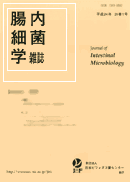All issues

Volume 26 (2012)
- Issue 4 Pages 211-
- Issue 3 Pages 159-
- Issue 1 Pages 3-
Predecessor
Volume 26, Issue 4
Displaying 1-2 of 2 articles from this issue
- |<
- <
- 1
- >
- >|
Reviews
-
Tomotari MITSUOKA2012 Volume 26 Issue 4 Pages 211-222
Published: 2012
Released on J-STAGE: December 28, 2012
JOURNAL FREE ACCESSI was shy by nature. In primary school, I was enthusiastic at drawing pictures, posters, calligraphy, and making butterfly specimens and models. When I entered the middle school of Seikei Gakuen, I was fortunate to have good teachers and friends. In the music class of Prof. Shin Kusakawa I was drawn to classical music. Prof. Kusatao Nakamura taught us the “preciousness of a pureness of heart”, which has been the guiding principle of my life. After the war, school began and I was deeply moved by the botany lecture given by Prof. Fumio Maekawa.I went to high school and suffered many anxieties. At that time, it was “Gakusei Ni Atau” by Prof. Eijirou Kawai and the speech by Prof. Tadashi Yanaihara that sustained my heart. I was admitted to the University of Tokyo, and had good teachers and friends again. I decided to become a researcher. I entered the postgraduate school and received the guidance of Prof. Yuichi Ochi. This was decisive for my life. I developed “BL agar” and discovered that bifidobacteria constituted one of the predominant organisms in human adults. This discovery formed the basis of my subsequent research. For two years from 1964, I studied in Germany and became acquainted with a few good friends, to whom I owe an inestimable debt of gratitude. After returning to Japan I developed a multipoint inoculator for rapid identification of bacteria from intestine, established a culture method for comprehensive investigation of intestinal flora and elucidated a number of rules governing the intestinal ecosystem. Thus, in 1980, “Intestinal bacteriology” was established. After that, I discovered the health effects of fermented milks and oligosaccharides and proposed “biogenics”. In the process of creation, “intuition” is an important factor. Intuition flashes suddenly in the head in the course of searching for truth with a pure heart and strong perseverance. Researchers should devote themselves wholeheartedly to integrity in their work. I believe firmly that “the fruit of creation is granted as a result of making endeavours with a pure heart”.
View full abstractDownload PDF (15020K) -
Junei KINJO, Ryota TSUCHIHASHI2012 Volume 26 Issue 4 Pages 223-233
Published: 2012
Released on J-STAGE: December 28, 2012
JOURNAL FREE ACCESSThe soybean is famous for being abundant in phytochemicals such as saponin and isoflavone. The isoflavone in particular is known to show estrogenic activity. In addition, the diuretic effects of the saponin are well-known effects of edible beans. On the other hand, Pueraria flowers show hepatoprotective activity, but the structutes of active principles closely resemble those of the soybean phytochemicals. We performed an experiment using intestinal bacteria of human origin, since the metabolic reaction showing how biological activity is affected by slight structural differences can be inferred by intestinal microbiota. The results were as follows. 1a) The Pueraria flower saponins showed more potent hepatoprotective activity because of the methyl group at C-24. 1b) The Pueraria flower isoflavones show more potent hepatoprotective activity than those of the soybean isoflavones. 2) The soybean isoflavones only showed estrogenic activity since their structures are more simple than those of the Pueraria flower isoflavones. 3) The soybean saponins showed more potent anti-complement (nephroprotective) activity than those of the Pueraria flower saponins. 4) The contribution of activities induced by intestinal bacteria was very large.
View full abstractDownload PDF (3538K)
- |<
- <
- 1
- >
- >|